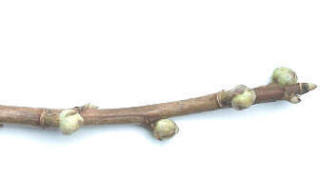Big Bud Mite infestation is best seen in mid-winter on both Blackcurrants and Hazels, with the affected buds being swollen and rounded - rather than the norm of pointed buds. (Black Currants more noticeable than Hazel - Cobnuts). It is not as ‘visible’ in the growing season owing to the foliage. You will not see the Big Bud Mite – simply the ‘evidence’ of their presence, by way of the rounded – rather than pointed – flowerbuds.
The Big Bud Mite is itself microscopic, entering the healthy buds in summer, then feed upon the sap in the healthy bud, causing the visible effect of the big rounded buds. The mites are generally invisible to the human eye – being fraction of a mm long.
The infected buds normally fail to open in the spring owing to the fact that they would have been populated by many hundreds of the larva which feed on the developing leaves within the bud. This leads to a general lack of foliage on the shrub – without which the Black currant cannot properly develop – and a general lack of vigour – affecting cropping and ultimately the death of the black currant bush.

There is now no available chemical spray that can be used by the amateur gardener. However, trials with the use of Sulphur have yielded some satisfactory results, but other phytotoxicity. We understand that trials are ongoing in this application – possibly combined with horticultural oils. This is NOT a recommendation – simply an explanation for background information
Here the rounded abnormal buds are clearly seen. They should be picked off individually in winter - ensuring that none are dropped, and burned. The Big Buds are caused by Galling.
A further problem is the possibility of the Big Bud Mite carrying the Reversion Virus which is again not treatable.
Control with small numbers of enlarged buds is simply by picking off the affected buds and burning. With badly affected plants, the whole bush should be removed and consigned to the fire.
It is important to deal with any outbreak by complete destruction of the infected buds o or the whole plant, for the mites can be transported to neighbouring bushes easily – and normally by a gust of wind.
It is possible – and advisable – to purchase new black currant bushed from certified nurseries that have non infected stock. Together with that, there is one variety which is resistant – ‘Ben Hope’
Other Blackcurrant Pest | Blackcurrant Leaf gall Midge - is different to Big Bud. | Aphids | Clearwing Moth |
Main Page for Apple Tree Problems